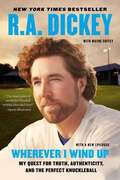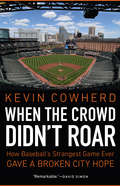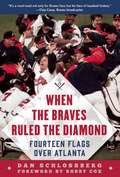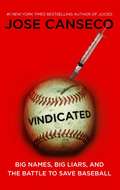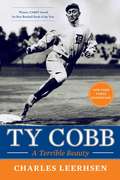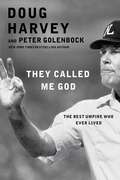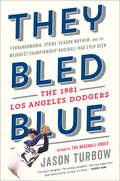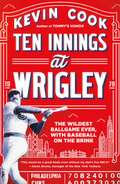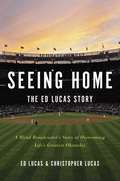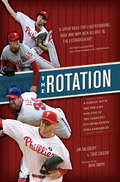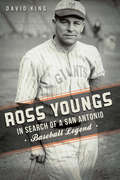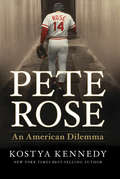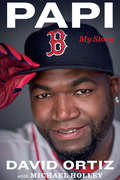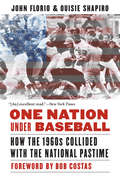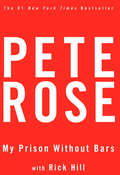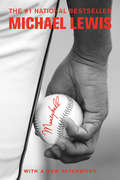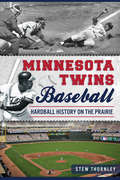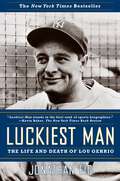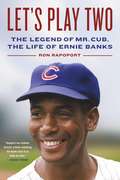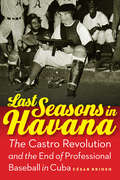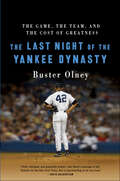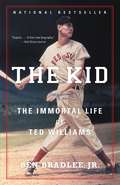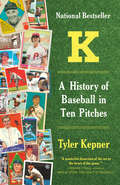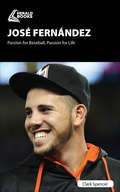Special Collections
Baseball: America's Greatest Pastime
Description: "Whoever wants to know the heart and mind of America had better learn baseball" -Jacques Barzun. Feel like you're walking on the field with this riveting collection of non-fiction books about baseball. #adults
- Table View
- List View
Wherever I Wind Up
by R. A. Dickey and Wayne CoffeyWith a new epilogue by author R.A. Dickey, winner of the 2012 Cy Young award
"An astounding memoir--haunting and touching, courageous and wise." - Jeremy Schaap, bestselling author, Emmy award-winning journalist, ESPN
In 1996, R.A. Dickey was the Texas Rangers' much-heralded No. 1 draft choice. Then, a routine physical revealed that his right elbow was missing its ulnar collateral ligament, and his lifelong dream--along with his $810,000 signing bonus--was ripped away. Yet, despite twice being consigned to baseball's scrap heap, Dickey battled back. Sustained by his Christian faith, the love of his wife and children, and a relentless quest for self-awareness, Dickey is now the starting pitcher for the Toronoto Blue Jays (he was previously a star pitcher for the New York Mets) and one of the National League's premier players, as well as the winner of the 2012 Cy Young award.
In Wherever I Wind Up, Dickey eloquently shares his quintessentially American tale of overcoming extraordinary odds to achieve a game, a career, and a life unlike any other.
When the Crowd Didn't Roar
by Kevin CowherdThe date is April 29, 2015. Baltimore is reeling from the devastating riots sparked by the death in police custody of twenty-five-year-old African American Freddie Gray.
Set against this grim backdrop, less than thirty-six hours after the worst rioting Baltimore has seen since the assassination of Martin Luther King in 1968, the Baltimore Orioles and the Chicago White Sox take the field at Camden Yards. It is a surreal event they will never forget: the only Major League game ever played without fans.
The eerily quiet stadium is on lockdown for public safety and because police are needed elsewhere to keep the tense city from exploding anew.
When the Crowd Didn’t Roar chronicles this unsettling contest—as well as the tragic events that led up to it and the therapeutic effect the game had on a troubled city.
The story comes vividly to life through the eyes of city leaders, activists, police officials, and the media that covered the tumultuous unrest on the streets of Baltimore, as well as the ballplayers, umpires, managers, and front-office personnel of the teams that played in this singular game, and the fans who watched it from behind locked gates.
In its own way, amid the uprising and great turmoil, baseball stopped to reflect on the fact that something different was happening in Baltimore and responded to it in an unprecedented way, making this the unlikeliest and strangest game ever played.
When the Braves Ruled the Diamond
by Dan SchlossbergFrom 1991 through 2005, the Atlanta Braves did something no pro sports team can match, finishing in first place for fourteen consecutive seasons.
During that stretch, the Braves paired powerful pitching with potent hitting that produced under pressure. Hall of Fame manager Bobby Cox won with veteran teams, young teams, slugging teams, and several times with teams that emphasized speed and defense. His teams captured on hundred wins in six different seasons.
In When the Braves Ruled the Diamond, now newly updated to include a discussion of the team's latest Hall of Fame inductees, former AP sportswriter Dan Schlossberg covers the record-breaking era that transformed Atlanta from the Bad-News Braves to America's Team.
With separate chapters on Cox, fabled pitching coach Leo Mazzone, and Hall of Fame pitchers Greg Maddux, Tom Glavine, and John Smoltz, this book also highlights the contributions of Andres Galarraga, Andruw Jones, Chipper Jones, Brian Jordan, Javy Lopez, Terry Pendleton, and many more Braves stars.
It features year-by-year summaries, Opening Day lineups, and even oddball anecdotes that explain why the fourteen-year streak may never be duplicated. It is the perfect gift for fans of baseball history as well as fans of the Atlanta Braves!
Vindicated
by Jose CansecoIn 2005, Jose Canseco blew the lid off Major League Baseball's steroid scandal -- and no one believed him. His New York Times bestselling memoir Juiced met a firestorm of criticism and outrage from the media, coaches, clubs, and players, many of whom Canseco had personally introduced to steroids -- with a needle in the ass. Baseball's former golden boy, Rookie of the Year, onetime Most Valuable Player, and owner of two World Series rings was called a liar. Now, steroids are back in the headlines. Record-breaking athletes are falling from grace, and the infamous Mitchell Report confirmed the names of major leaguers who have indeed used steroids while others remain under investigation. The answer is clear: Jose Canseco told the truth. And why wouldn't he? He started it all. Finally, in Vindicated, Canseco picks up where Juiced left off, revealing details even more shocking than in his controversial first book. He spills never-before-implicated names -- arguably the biggest in the game of baseball -- and explores the mystery of one celebrated player about whom key information was suddenly excised from Juiced at the last minute. He talks candidly about what the Mitchell Report did -- and didn't -- get right, why steroid use became so rampant, and how his life has changed since he tore the lid off Pandora's box. Lest there be any doubt about theveracity of his claims, Canseco subjected himself to three lie detector tests, one of which was conducted by a former FBI special agent and top polygraph examiner who investigated the Unabomber, Whitewater, the Oklahoma City bombing, and the 1993 bombing of the World Trade Center. Transcripts of those taped interviews are also included in this straight-talking examination of the current state of baseball. This time, he's not just out to clear his name. He's out to clean up the game.
Ty Cobb
by Charles LeerhsenA fascinating and authoritative biography of perhaps the most controversial player in baseball history, Ty Cobb—&“The best work ever written on this American sports legend: It&’s a major reconsideration of a reputation unfairly maligned for decades&” (The Boston Globe).Ty Cobb is baseball royalty, maybe even the greatest player ever. His lifetime batting average is still the highest in history, and when he retired in 1928, after twenty-one years with the Detroit Tigers and two with the Philadelphia Athletics, he held more than ninety records. But the numbers don’t tell half of Cobb’s tale. The Georgia Peach was by far the most thrilling player of the era: When the Hall of Fame began in 1936, he was the first player voted in. But Cobb was also one of the game’s most controversial characters. He got in a lot of fights, on and off the field, and was often accused of being overly aggressive. Even his supporters acknowledged that he was a fierce competitor, but he was also widely admired. After his death in 1961, however, his reputation morphed into that of a virulent racist who also hated children and women, and was in turn hated by his peers. How did this happen? Who is the real Ty Cobb? Setting the record straight, Charles Leerhsen pushed aside the myths, traveled to Georgia and Detroit, and re-traced Cobb’s journey from the shy son of a professor and state senator who was progressive on race for his time to America’s first true sports celebrity. The result is a “noble [and] convincing” (The New York Times Book Review) biography that is “groundbreaking, thorough, and compelling…The most complete, well-researched, and thorough treatment that has ever been written” (The Tampa Tribune).
They Called Me God
by Peter Golenbock and Doug HarveyIn the pageantry of baseball, one select group is virtually unknown in the outside world, derided by fans, faced with split-second choices that spell victory or defeat. These men are up-close observers of the action, privy to inside jokes, blood feuds, benches-clearing brawls, and managers' expletive-filled tirades.
In this wonderful memoir, Hall of Fame umpire Doug Harvey takes us within baseball as you've never seen it, with unforgettable inside stories of baseball greats such as Willie Mays, Sandy Koufax, and Whitey Herzog.
Doug Harvey was a California farm boy, a high school athlete who nevertheless knew that what he really wanted was to become an unsung hero--a major league umpire. Working his way through the minor leagues, earning three hundred dollars a month, he survived just about everything, even riots in stadiums in Puerto Rico. And while players and other umps hit the bars at night, Harvey memorized the rule book. In 1962, he broke into the bigs and was soon listening to rookie Pete Rose worrying that he would be cut by the Reds and laying down the law with managers such as Tommy Lasorda and Joe Torre.
This colorful memoir takes the reader behind the plate for some of baseball's most memorable moments, including: · Roberto Clemente's three thousandth and final hit · The "I don't believe what I just saw" heroic three-and-two pinch-hit home run by Kirk Gibson in the '88 World Series · The nail-biting excitement of the close-fought '68 World Series, when Doug called St. Louis Cardinal Lou Brock out at home plate and turned the trajectory of the series But beyond the drama, Harvey turned umpiring into an art. He was a man so respected, whose calls were so feared and infallible, that the players called him God.
And through it all, he lived by three rules: never take anything from a player, never back down from a call, and never carry a grudge.
A book for anyone who loves baseball, They Called Me God is a funny and fascinating tale of on- and off-the-field action, peopled by unforgettable characters from Bob Gibson to Nolan Ryan, and a treatise on good umpiring techniques. In a memoir that transcends sport, Doug Harvey tells a gripping story of responsibility, fairness, and honesty.
They Bled Blue
by Jason Turbow“A skillful mixture of biographies, on-field action, and behind-the-scenes baseball politics in a story with a happy ending for Dodgers fans.” —Kirkus ReviewsThe award–winning author of Dynastic, Fantastic, Bombastic and The Baseball Codes delivers a sprawling, mad tale of excess and exuberance, the likes of which could only have occurred in that place, at that time.That it culminated in an unlikely World Series win—during a campaign split by the longest player strike in baseball history—is not even the most interesting thing about this team. The Dodgers were led by the garrulous Tommy Lasorda—part manager, part cheerleader—who unyieldingly proclaimed devotion to the franchise through monologues about bleeding Dodger blue and worshiping the “Big Dodger in the Sky,” and whose office hosted a regular stream of Hollywood celebrities. Steve Garvey, the All-American, All-Star first baseman, had anchored the most durable infield in major league history, and, along with Davey Lopes, Bill Russell, and Ron Cey, was glaringly aware that 1981 would represent the end of their run together. The season’s real story, however, was one that nobody expected at the outset: a chubby lefthander nearly straight out of Mexico, twenty years old with a wild delivery and a screwball as his flippin’ out pitch. The Dodgers had been trying for decades to find a Hispanic star to activate the local Mexican population; Fernando Valenzuela was the first to succeed, and it didn’t take long for Fernandomania to sweep far beyond the boundaries of Chavez Ravine.They Bled Blue is the rollicking yarn of the Los Angeles Dodgers’ crazy 1981 season.
Ten Innings at Wrigley
by Kevin CookThe dramatic story of a legendary 1979 slugfest between the Chicago Cubs and the Philadelphia Phillies, full of runs, hits, and subplots, at the tipping point of a new era in baseball historyIt was a Thursday at Chicago’s Wrigley Field, mostly sunny with the wind blowing out.
Nobody expected an afternoon game between the Philadelphia Phillies and Chicago Cubs on May 17, 1979, to be much more than a lazy early-season contest matching two teams heading in opposite directions—the first-place Phillies and the Cubs, those lovable losers—until they combined for thirteen runs in the first inning. “The craziest game ever,” one player called it. “And then the second inning started.”
Ten Innings at Wrigley is Kevin Cook’s vivid account of a game that could only have happened at this ballpark, in this era, with this colorful cast of heroes and heels: Hall of Famers Mike Schmidt and Bruce Sutter, surly slugger Dave Kingman, hustler Pete Rose, unlucky Bill Buckner, scarred Vietnam vet Garry Maddox, troubled relief pitcher Donnie Moore, clubhouse jester Tug McGraw, and two managers pulling out what was left of their hair.
It was the highest-scoring ballgame in a century, and much more than that. Bringing to life the run-up and aftermath of a contest The New York Times called “the wildest in modern history,” Cook reveals the human stories behind the game—and how money, muscles and modern statistics were about to change baseball forever.
Seeing Home
by Ed Lucas and Christopher LucasSoon to be a major motion picture, Seeing Home: The Ed Lucas Story is the incredible true tale of a beloved Emmy-winning blind broadcaster who refused to let his disability prevent him from overcoming many challenging obstacles and achieving his dreams.In 1951, when he was only twelve years old, Ed Lucas was hit between the eyes by a baseball during a sandlot game in Jersey City. He lost his sight forever. To cheer him up, his mother wrote letters to baseball superstars of the day, explaining her son’s condition. Soon Ed was invited into their clubhouses and dugouts, as the players and coaches personally made him feel at home. Despite the warm reception he got from his heroes, Ed was told repeatedly by others that he would never be able to accomplish anything worthwhile because of his limitations. But Hall-of-Famer Phil Rizzuto became Ed’s mentor and encouraged him to pursue his passion—broadcasting. Ed then overcame hundreds of barriers, big and small, to become a pioneer—the first blind person covering baseball on a regular basis, a career he has successfully continued for six decades. Ed may have lost his sight, but he never lost his faith, which got him through many pitfalls and dark days. When Ed’s two sons were very young, his wife walked out and left him to raise them all by himself, which he did. Six years later, Ed’s ex-wife returned and sued him for full custody, saying that a blind man shouldn’t have her kids. The judge agreed, tearing Ed's sons away from their father's loving home. Ed fought the heartbreaking decision with appeals all the way up to the highest level of the court system. Eventually, he prevailed, marking the very first time in US history that a disabled person was awarded custody over a non-disabled spouse. Even in his later years, Ed is still enjoying a remarkably blessed life. In 2006, he married his second wife, Allison, at home plate in old Yankee Stadium, the only time that such a thing ever happened on that iconic spot. Yankee owner George Steinbrenner himself catered the whole affair, which was shown live on national television. Seeing Home: The Ed Lucas Story is truly a magical read and a universally uplifting and inspirational tale for everyone, whether or not you happen to be a sports fan. Over his long and amazing life, Ed has collected hundreds of anecdotes from his personal relationships and encounters with everyone, from kings and presidents to movie stars and sports Hall-of-Famers, many of which he shares in this memoir, using his trademark humorous and engaging style, cowritten with his youngest son, Christopher.
The Rotation
by Jim Salisbury and Todd ZoleckiNot since 1957 has one major league team's pitching staff boasted three pitchers (Roy Halladay, Cliff Lee, and Roy Oswalt) in the Top Ten in career winning-percentage.
Plus, the Philadelphia Phillies' 2011 rotation also happens to include Cole Hamels-the 2008 NLCS and World Series MVP-and an alternating fifth starter. This awe-inducing rotation has been the talk of baseball since coming together in December 2010.
They were featured on the cover of Sports Illustrated's 2011 baseball- preview edition, interviewed on the MLB Network on opening day of spring training, covered in the New York Times Magazine, and mentioned in numerous newspapers and magazines nationwide.
Authored by two of the most knowledgable and connected Phillies beat writers, The Rotation is a remarkably detailed day-in-the-life story of one complete season with a Major League Baseball starting-pitching staff.
The authors offer deep daily access to the Phillies players, coaches, and front-office staff, as well as the players and staff of other major league teams and the national baseball media.
With firsthand reporting and extensive interviews, plus two full-color photo inserts, this is a fascinating and detailed look into the day-to-day operation of what is arguably the greatest pitching rotation ever assembled. It is a must-read for Phillies fans and general baseball fans alike.
Ross Youngs
by David KingThough Ross Youngs has been enshrined in the National Baseball Hall of Fame since 1972, few have given his remarkable career its due. Born in Shiner and raised in San Antonio, Youngs played his first game as a professional at the age of sixteen, and just three years later, his contract was purchased by the New York Giants, one of baseball's elite teams in the early twentieth century. Tragically, his promising career ended when he died from an illness at age thirty in 1927. Join author David King in a journey to discover the amazing Youngs as he was and the incredible legacy he left behind.
Pete Rose
by Kostya KennedyPete Rose played baseball with a singular and headfirst abandon that endeared him to fans and peers, even as it riled others--a figure at once magnetic, beloved and polarizing. Rose has more base hits than anyone in history, yet he is not in the Hall of Fame. Twenty-five years ago he was banished from the game for gambling, then ruled ineligible for Cooperstown.
Today, the question "Does Pete Rose belong in the Hall of Fame?" has evolved into perhaps the most provocative in sports, a layered, slippery and ever-relevant moral conundrum. How do we evaluate the Hit King now, at a time when steroid cheats appear on the Hall of Fame ballot even as Rose is denied? What do we make of this happily unrepentant gambler, this shameless but beguiling showman whose post-baseball journey has led him to a curious reality show and to the streets of Cooperstown to hawk his signature, his story, himself?
Best-selling author Kostya Kennedy delivers an evocative answer in his fascinating re-examination of Pete Rose's life; from his cocky and charismatic early years through his storied playing career to his bitter war against baseball's hierarchy to the man we find today--still incorrigible, still adored by many.
Where has his improbable saga landed him in the redefined, post-steroid world? Do we feel any differently about Pete Rose today? Should we?
Papi
by David Ortiz and Michael HolleyThe Red Sox Hall of Famer and World Series MVP tells the story of his life and career in a sports memoir that &“lives up to its &‘no-holds-barred&’ billing&” (Washington Post). David &“Big Papi&” Ortiz is a baseball icon and one of the most popular figures ever to play the game. A star player with the Boston Red Sox for fifteen years, Ortiz helped to win three World Series, bringing back a storied franchise from &“never wins&” to &“always wins.&” As he launched balls into the stands again and again, he helped silence the naysayers while capturing the imaginations of millions of fans. Ortiz made Boston and the Red Sox his home, his place of work, and his legacy. In Papi, Ortiz tells his story in his own words, opening up as never before. The result is a revelatory tale of a storied career—all told by a legendary player with a lot to say at the end of his time in the game. This edition of Papi includes a new afterword. &“Baseball fans of all loyalties will enjoy learning about [Ortiz&’s] unique experiences in and out of the game.&” —Library Journal &“The rise of Ortiz from scrap-heap bench player to Hall of Famer is an unlikely and entertaining story, and engagingly told.&” —Washington Post
One Nation Under Baseball
by Bob Costas and Ouisie Shapiro and John FlorioOne Nation Under Baseball highlights the intersection between American society and America’s pastime during the 1960s, when the hallmarks of the sport—fairness, competition, and mythology—came under scrutiny.
John Florio and Ouisie Shapiro examine the events of the era that reshaped the game: the Koufax and Drysdale million-dollar holdout, the encroachment of television on newspaper coverage, the changing perception of ballplayers from mythic figures to overgrown boys, the arrival of the everyman Mets and their free-spirited fans, and the lawsuit brought against team owners by Curt Flood.
One Nation Under Baseball brings to life the seminal figures of the era—including Bob Gibson, Marvin Miller, Tom Seaver, and Dick Young—richly portraying their roles during a decade of flux and uncertainty.
My Prison Without Bars
by Pete Rose and Rick HillPete Rose holds more Major League Baseball records than any other player in history. He stands alone as baseball's hit king having shattered the previously "unbreakable" record held by Ty Cobb. He is a blue-collar hero with the kind of old-fashioned work ethic that turned great talent into legendary accomplishments.
Pete Rose is also a lifelong gambler and a sufferer of oppositional defiant disorder. For the past 13 years, he has been banned from baseball and barred from his rightful place in the Hall of Fame-- accused of violating MLB's one taboo. Rule 21 states that no one associated with baseball shall ever gamble on the game. The punishment is no less than a permanent barring from baseball and exclusion from the Hall of Fame.
Pete Rose has lived in the shadow of his exile. He has denied betting on the game that he loves. He has been shunned by MLB, investigated by the IRS, and served time for tax charges in the U.S. Penitentiary in Marion, Illinois.But he's coming back.
Pete Rose has never been forgotten by the fans who loved him throughout his 24-year career. The men he played with have stood by him. In this, his first book since his very public fall from grace, Pete Rose speaks with great candor about all the outstanding questions that have kept him firmly in the public eye. He discloses what life was like behind bars, discusses the turbulent years of his exile, and gives a vivid picture of his early life and baseball career. He also confronts his demons, tackling the ugly truths about his gambling and his behavior.
My Prison Without Bars is Pete Rose's full accounting of his life. No one thinks he's perfect. He has made mistakes--big ones. And he is finally ready to admit them.
Moneyball
by Michael LewisMichael Lewis’s instant classic may be “the most influential book on sports ever written” (People), but “you need know absolutely nothing about baseball to appreciate the wit, snap, economy and incisiveness of [Lewis’s] thoughts about it” (Janet Maslin, New York Times). One of GQ's 50 Best Books of Literary Journalism of the 21st Century Just before the 2002 season opens, the Oakland Athletics must relinquish its three most prominent (and expensive) players and is written off by just about everyone—but then comes roaring back to challenge the American League record for consecutive wins. How did one of the poorest teams in baseball win so many games? In a quest to discover the answer, Michael Lewis delivers not only “the single most influential baseball book ever” (Rob Neyer, Slate) but also what “may be the best book ever written on business” (Weekly Standard). Lewis first looks to all the logical places—the front offices of major league teams, the coaches, the minds of brilliant players—but discovers the real jackpot is a cache of numbers?numbers!?collected over the years by a strange brotherhood of amateur baseball enthusiasts: software engineers, statisticians, Wall Street analysts, lawyers, and physics professors. What these numbers prove is that the traditional yardsticks of success for players and teams are fatally flawed. Even the box score misleads us by ignoring the crucial importance of the humble base-on-balls. This information had been around for years, and nobody inside Major League Baseball paid it any mind. And then came Billy Beane, general manager of the Oakland Athletics. He paid attention to those numbers?with the second-lowest payroll in baseball at his disposal he had to?to conduct an astonishing experiment in finding and fielding a team that nobody else wanted. In a narrative full of fabulous characters and brilliant excursions into the unexpected, Michael Lewis shows us how and why the new baseball knowledge works. He also sets up a sly and hilarious morality tale: Big Money, like Goliath, is always supposed to win . . . how can we not cheer for David?
Minnesota Twins Baseball
by Stew ThornleyFor more than half a century, Minnesotans have been treated to the memorable players and teams of the Minnesota Twins.
From the Ruthian blasts of Harmon Killebrew and Kirby Puckett to a successful brand of "small ball," the Twins have fielded competitive teams at Metropolitan Stadium, the Metrodome and Target Field. But prior to its arrival in 1961, the team also had a storied past in Washington that included Walter Johnson, the greatest pitcher of the Deadball Era, if not all time.
Sports historian Stew Thornley highlights the lesser-known events in the club's history, from the area's attempts to lure a major-league team to town in the 1950s to then-owner Calvin Griffith's campaign to regionally rename the team.
He also pays tribute to the rich heritage of baseball before the Twins, marked by minor-league teams such as the St. Paul Saints and Minneapolis Millers, which produced future Hall of Famers Willie Mays, Duke Snider, Ted Williams and Roy Campanella.
Luckiest Man
by Jonathan EigThe definitive account of the life and tragic death of baseball legend Lou Gehrig.Lou Gehrig was a baseball legend—the Iron Horse, the stoic New York Yankee who was the greatest first baseman in history, a man whose consecutive-games streak was ended by a horrible disease that now bears his name. But as this definitive new biography makes clear, Gehrig’s life was more complicated—and, perhaps, even more heroic—than anyone really knew. Drawing on new interviews and more than two hundred pages of previously unpublished letters to and from Gehrig, Luckiest Man gives us an intimate portrait of the man who became an American hero: his life as a shy and awkward youth growing up in New York City, his unlikely friendship with Babe Ruth (a friendship that allegedly ended over rumors that Ruth had had an affair with Gehrig’s wife), and his stellar career with the Yankees, where his consecutive-games streak stood for more than half a century. What was not previously known, however, is that symptoms of Gehrig’s affliction began appearing in 1938, earlier than is commonly acknowledged. Later, aware that he was dying, Gehrig exhibited a perseverance that was truly inspiring; he lived the last two years of his short life with the same grace and dignity with which he gave his now-famous “luckiest man” speech. Meticulously researched and elegantly written, Jonathan Eig’s Luckiest Man shows us one of the greatest baseball players of all time as we’ve never seen him before.
Let's Play Two
by Ron RapoportThe definitive and revealing biography of Chicago Cubs legend Ernie Banks, one of America's most iconic, beloved, and misunderstood baseball players, by acclaimed journalist Ron Rapoport.
Ernie Banks, the first-ballot Hall of Famer and All-Century Team shortstop, played in fourteen All-Star Games, won two MVPs, and twice led the Major Leagues in home runs and runs batted in. He outslugged Willie Mays, Hank Aaron, and Mickey Mantle when they were in their prime, but while they made repeated World Series appearances in the 1950s and 60s, Banks spent his entire career with the woebegone Chicago Cubs, who didn't win a pennant in his adult lifetime.
Today, Banks is remembered best for his signature phrase, "Let's play two," which has entered the American lexicon and exemplifies the enthusiasm that endeared him to fans everywhere. But Banks's public display of good cheer was a mask that hid a deeply conflicted, melancholy, and often quite lonely man.
Despite the poverty and racism he endured as a young man, he was among the star players of baseball's early days of integration who were reluctant to speak out about Civil Rights. Being known as one of the greatest players never to reach the World Series also took its toll. At one point, Banks even saw a psychiatrist to see if that would help. It didn't. Yet Banks smiled through it all, enduring the scorn of Cubs manager Leo Durocher as an aging superstar and never uttering a single complaint.
Let's Play Two is based on numerous conversations with Banks and on interviews with more than a hundred of his family members, teammates, friends, and associates as well as oral histories, court records, and thousands of other documents and sources. Together, they explain how Banks was so different from the caricature he created for the public.
The book tells of Banks's early life in segregated Dallas, his years in the Negro Leagues, and his difficult life after retirement; and features compelling portraits of Buck O'Neil, Philip K. Wrigley, the Bleacher Bums, the doomed pennant race of 1969, and much more from a long-lost baseball era.
Last Seasons in Havana
by César BriosoLast Seasons in Havana explores the intersection between Cuba and America’s pastime from the late 1950s to the early 1960s, when Fidel Castro overthrew Cuban dictator Fulgencio Batista. César Brioso takes the reader through the triumph of the revolution in 1959 and its impact on professional baseball in the seasons immediately following Castro’s rise to power. Baseball in pre‑Castro Cuba was enjoying a golden age.
The Cuban League, which had been founded in 1878, just two years after the formation of the National League, was thriving under the auspices of organized baseball. Throughout the first half of the twentieth century, players from the Major Leagues, Minor Leagues, and Negro Leagues had come to Cuba to play in the country’s wholly integrated winter baseball league.
Cuban teams had come to dominate the annual Caribbean Series tournament, and Havana had joined the highest levels of Minor League Baseball, fielding the Havana Sugar Kings of the Class AAA International League. Confidence was high that Havana might one day have a Major League team of its own.
But professional baseball became one of the many victims of Castro’s Communist revolution. American players stopped participating in the Cuban League, and Cuban teams moved to an amateur, state‑sponsored model. Focusing on the final three seasons of the Cuban League (1958–61) and the final two seasons of the Havana Sugar Kings (1959–60), Last Seasons in Havana explores how Castro’s rise to power forever altered Cuba and the course of a sport that had become ingrained in the island’s culture over the course of almost a century.
The Last Night of the Yankee Dynasty
by Buster OlneyFor six extraordinary years around the turn of the millennium, the Yankees were baseball's unstoppable force, with players such as Paul O'Neill, Derek Jeter, and Mariano Rivera. But for the players and the coaches, baseball Yankees-style was also an almost unbearable pressure cooker of anxiety, expectation, and infighting. With owner George Steinbrenner at the controls, the Yankees money machine spun out of control. In this new edition of The Last Night of the Yankee Dynasty, Buster Olney tracks the Yankees through these exciting and tumultuous seasons, updating his insightful portrait with a new introduction that walks readers through Steinbrenner's departure from power, Joe Torre's departure from the team, the continued failure of the Yankees to succeed in the postseason, and the rise of Hank Steinbrenner. With an insider's familiarity with the game, Olney reveals what may have been an inevitable fall that last night of the Yankee dynasty, and its powerful aftermath.
The Kid
by Ben BradleeAt long last, the epic biography Ted Williams deserves--and that his fans have been waiting for. Williams was the best hitter in baseball history. His batting average of .406 in 1941 has not been topped since, and no player who has hit more than 500 home runs has a higher career batting average.
Those totals would have been even higher if Williams had not left baseball for nearly five years in the prime of his career to serve as a Marine pilot in WWII and Korea. He hit home runs farther than any player before him--and traveled a long way himself, as Ben Bradlee, Jr.'s grand biography reveals.
Born in 1918 in San Diego, Ted would spend most of his life disguising his Mexican heritage. During his 22 years with the Boston Red Sox, Williams electrified crowds across America--and shocked them, too: His notorious clashes with the press and fans threatened his reputation.
Yet while he was a God in the batter's box, he was profoundly human once he stepped away from the plate. His ferocity came to define his troubled domestic life. While baseball might have been straightforward for Ted Williams, life was not.
THE KID is biography of the highest literary order, a thrilling and honest account of a legend in all his glory and human complexity. In his final at-bat, Williams hit a home run. Bradlee's marvelous book clears the fences, too.
K
by Tyler KepnerFrom the New York Times baseball columnist, an enchanting, enthralling history of the national pastime as told through the craft of pitching, based on years of archival research and interviews with more than three hundred people from Hall of Famers to the stars of today
The baseball is an amazing plaything. We can grip it and hold it so many different ways, and even the slightest calibration can turn an ordinary pitch into a weapon to thwart the greatest hitters in the world. Each pitch has its own history, evolving through the decades as the masters pass it down to the next generation. From the earliest days of the game, when Candy Cummings dreamed up the curveball while flinging clamshells on a Brooklyn beach, pitchers have never stopped innovating.
In K: A History of Baseball in Ten Pitches, Tyler Kepner traces the colorful stories and fascinating folklore behind the ten major pitches. Each chapter highlights a different pitch, from the blazing fastball to the fluttering knuckleball to the slippery spitball. Infusing every page with infectious passion for the game, Kepner brings readers inside the minds of combatants sixty feet, six inches apart.
Filled with priceless insights from many of the best pitchers in baseball history including twenty-two Hall of Famers--from Bob Gibson, Steve Carlton, and Nolan Ryan to Greg Maddux, Mariano Rivera, and Clayton Kershaw--K will be the definitive book on pitching and join such works as The Glory of Their Times and Moneyball as a classic of the genre.
Juiced
by Jose CansecoA star of Major League Baseball tells the story of wide-spread use of steroids throughout the sport.
José Fernández
by Clark SpencerThe inspiring life and career of the Miami Marlins’ pitcher, the youngest MLB All-Star in team history, who died in a tragic boating accident in 2016.
In August 2016, José Fernández’s girlfriend, Maria Arias, presented him with a special cake at a family dinner to celebrate that they were going to have a baby. For Fernandez, becoming a father marked a new milestone in a young life that had already been brimming with milestones: fleeing Cuba multiple times before making it to freedom in the United States; drafted by the Miami Marlins in the first round in 2011; making the 2013 and 2016 All-Star teams; winning the National League Rookie of the Year award in 2013, and becoming a US citizen in 2015.
Suddenly, early in the morning of September 25, his life came to a tragic end in a boating crash that left his family, friends, and the baseball world devastated. This book is a Miami Herald tribute to baseball’s unforgettable young pitching sensation and lover of life.
